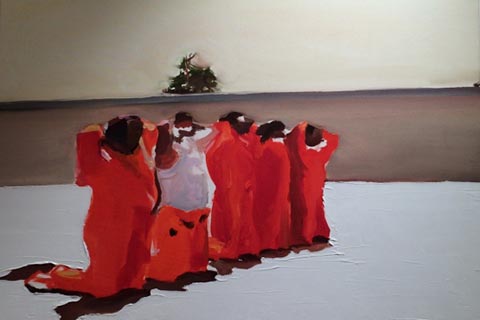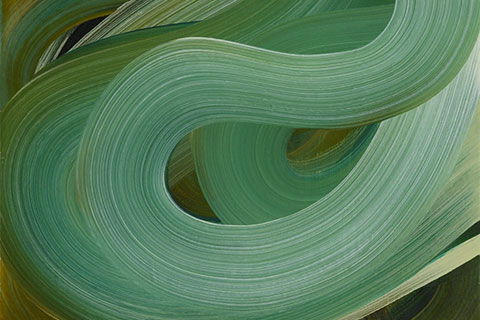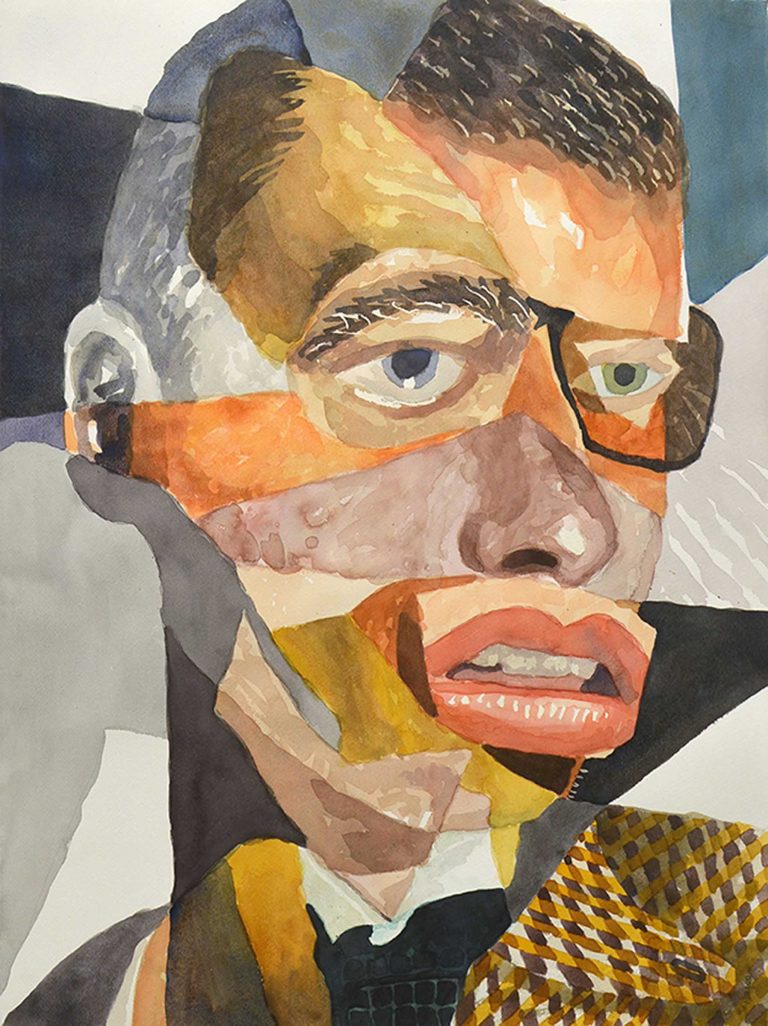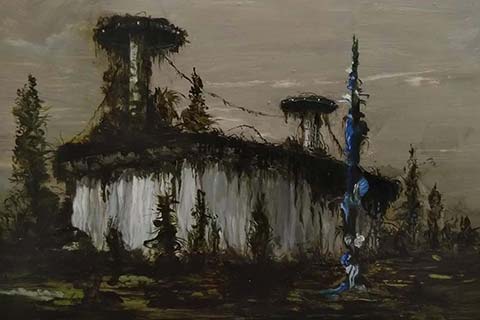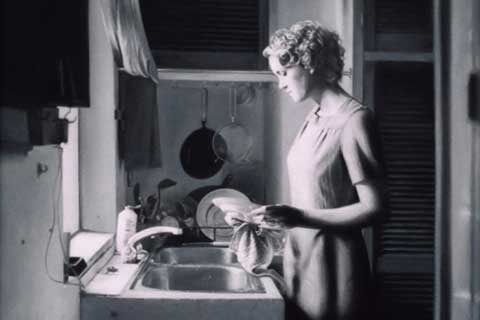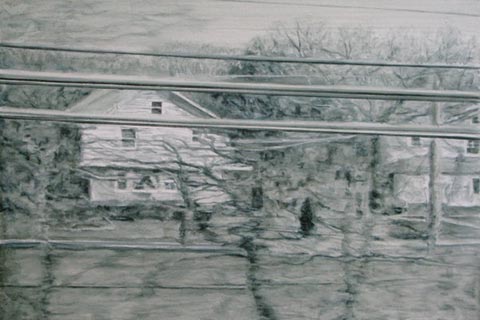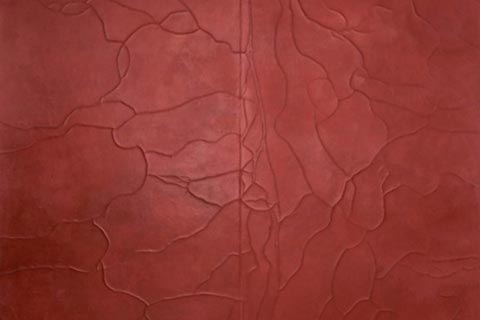Katherine Russell in conversation with Marguerite Horner
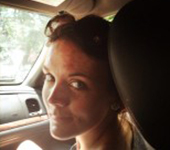
Marguerite Horner: Right, how do you start a painting Katherine?
Katherine Russell: Basically I have a lot of different source material that I gather, so I have loads of photographic material, piles and piles of it and I tend to work thematically. So, at the moment I am looking at ‘Filmic’ and so I have been taking lots of images of films and I use those images as a starting point, maybe for a composition or for a colour or an idea. But then I tend to discard them and move forward. The paint basically takes over, and it just becomes much more intuitive.
MH: Do you only use the brush, and can you talk about the tactile qualities of the work.
KR: I use the brush, I use my fingers, I use cloth I use whatever I can find in my studio, old scrubbing up brushes, I love finding new ways of applying paint and taking it away as well. And at the moment I am really trying to experiment with reducing my palette and reducing the way I sort of explain the paint, so therefore to see how much I can take away, but still have something resonate.
MH: Interesting.. Do you know what you will end up with when you start?
KR: No, (laughs) never…
(they both laugh)
KR: I always think.. I find the ones when I do, aren’t successful and normally I have an idea in my head, but tend to go off on a tangent. I don’t want to know, in a way, because if I did it would just be too straightforward. I like the way that the paint takes over, or the way that I might have applied something leads me in a different direction. But, the ideas that I am looking at tend to be the same when I am working on a group of paintings.
MH: So you have a dialogue with the paint.
KR: Yes… And I tend to work on a few different ones all at the same time, or have them around me, so they inform each other.
MH: Are the sides of the canvas, board or framing important?
KR: I think Not, I don’t tend to frame my work, the thing that is important for me, is that my work needs a lot of space around it to see it. Or, I think it works best if you have a lot of white wall around it, so I tend to just paint edges just to make it clean.. and clear and not have anything distracting the viewer. A lot of space around, so the viewer can contemplate it and really get immersed.
MH: How does the scale affect the work?
KR: Well, I have been playing around with scale at the moment, I’m working in quite small scale and quite like it for this show because they’re quite intimate and I like the idea of them sort of being small objects to contemplate. Something about playing with the drama with them, but still making them powerful, even on a very small scale. But before that I was working on quite a huge scale, so I like to jump around.
MH: What’s the size of the huge scale?
KR: Well, for me its huge, it’s one and a half metres, in fact I have one painting in this show, which is more of a crossover piece; Which is looking at lots of forests and woodlands and a darker subject matter. So I have gone from giant to tiny.
MH: What are your inspirations?
KR: My inspirations in terms of other painters…or just in general?
MH: Well, Both.
KR: Inspiration wise, whenever I go on trips anywhere I draw, I photograph anything that interests me. Equally at home I am constantly collecting a diversity of images from film stills to mass media reportage; everything around me. So, I have an ever-growing pool of visual material that I draw on.
In terms of artists I look at a wide range, so at the moment I’ve been looking at Ana Bjerger’s work, Chantal Joffe, Michael Borremans, who I quite like at the moment. But also Freud, Tuymans , Van Eyck,…Romantic painting. I tend to flit quite a bit, but whatever interests me at the time.
MH: I like Borremans.
KR: Do you. I really like the fact that he completely draws you in and then you suddenly see that he’s torn away what you think is meant to be there, and I like that, that it is making you aware.
MH: That it’s not obvious.
KR: Yes, I like that play.
MH: And they are painterly aren’t they.
KR: Yes, I love the one, there’s this one.. I don’t know what it’s called with the hands and the gloves and it’s dripping.
MH: ‘Green Hands.’
KR: Yes, that’s it, ‘green hands’.. almost dripping..
MH: And there’s one called toy town.
KR: Yes, which one is that.
MH: It’s like you are looking down on a town, seeing..
KR: Yes, that’s a real scale one.
MH: How important is colour to you?
KR: Colour is very important. I am playing around at the moment with using much more muted colours, subdued. I am reducing the amount of different colours that I use to mix, to see what sort of impact it has on the work, because I am experimenting with reduction in general.
MH: Is there a reason for that?
KR: It’s more an experiment. I tend to get quite carried away with colour, I am sort of like a kid in a candy shop and, yes I wanted to see what it would do to my work, by putting constraints. I don’t always follow them. With the snow drive painting; I really wanted to get a feeling of ice cream and that with the snow you can feel the crunching and the cold and the colours are almost candy like. I like that. But in terms of this show, the colour palette moves all over the place, because the works are all drawn together on the idea of ‘Filmic.’
MH: Did you study colour theory?
KR: I did, but I guess the way I play with colour is much more intuitive. I don’t think I approach it in a very formalized way.
MH: Yes, but if you are trying to make something look like snow, do you put a blue shadow in to make it look more like.. snow?!
KR: Yes!
(they both laugh)
But, I think I just do that instinctively.
MH: You already know it.
KR: Yes, when I mix colours it is very instinctive.
MH: …it’s part of who you are.
KR: Yes, and it’s trial and error too. And sometimes the errors end up sending you off in a different direction, I’m not against that.
MH: But you know things like to make a yellow darker you would add purple. Not everyone know that, that you add the complimentary colour. Unless they have learnt that at school, before they go to Art College!
KR: Yes, that’s true!
…and I also think I am very wary of becoming too reliant on certain colours, because I tend to go through phases with colours, I don’t know if you do? Where you are completely in love with a colour, whether it be alzarin crimson, and I become obsessive.. I have to be careful not to overuse it. I never use black.
MH: That’s another rule isn’t it.
KR: Yes, and also I don’t like it, it just deadens things I find.
MH: Was it Monet or Manet who used black?
KR: It was Manet.
MH: He was untutored, and I saw the recent show and some of the work was dreadful and some was fantastic. It was very encouraging to see the dreadful ones!
KR: Yes. Always is!
MH: Same with Van Gogh, early work.
KR: With a lot of artists you think thank goodness you moved on from that.
MH: When he meets Gauguin his palette completely changes, makes you think well, just because you start off somewhere, doesn’t mean you are going to carry on there. You can meet somebody and they can totally open your eyes up.
KR: Absolutely, and just seeing someone else’s work, going to their show.. I saw this show of this painter; Gideon Rubin, I don’t think they’re very well known, quite young. The show was in Rokeby gallery. I think it’s a he. His work got me onto the idea of reduction; saying just enough without over stating a point. I really like that it has the right balance, just enough there. That set me off.
MH: It’s sometimes more powerful isn’t it.
I was questioned in my own interview as I only use two colours. I put the colour on as a glaze… I admire the way you use colour, but it’s just not something that I am comfortable with. Because it is not intuitive in the way that it is for you.
KR: But I think that the way you use two colours from the work that I saw, that you can say just the right amount, and get the feeling I’m guessing that you want to. If you suddenly poured every single colour of the rainbow into there, it wouldn’t work the way that you work. It’s restrained, and the way the paint is applied, that is what talks to you.
MH: I know. Through other works sometimes … you see colour as so seductive, it’s delicious, you want it, you desire it
KR: I know. It is. I love it when it’s almost edible…
MH: Do you know (could not remember name at time) the artist who does pictures of San Francisco, vertical, used to do sweeties in the 60’s. (Later remembered as Wayne Theobald.) Will have to email you.
KR: No, I don’t think so. I will have to look him up.
MH: I think you would enjoy the way he uses colour and the way you bring colours in, especially his later work. Yes, he uses shadows that come across, like in your work. Because the light in San Francisco and in America I find generally, you have this harshness of light, which you don’t here, it’s so grey in England.
KR: I totally agree. I have just been in the States and the feeling of, well space anyway, but it just feels so much bigger, the sky is so much clearer, and the quality of light is just completely different. It’s as you say, very sharp. Very defined, completely different.
MH: Inspiring, the way the sun is, in the sky..
KR: Definitely, its almost blinding.
MH: Yes, but its not like in the continent, where it’s bright, where the colour is bleached out. It is still strong, like autumn sunshine, low in the sky.
KR: That is true.
MH: How do you know when a painting is finished?
KR: I think again, intuition. Normally, the painting announces itself in that way. I am always looking for a balance between saying as much as I want to, but not too much. Not overworking. Not it becoming too decorative, or for the sake of itself. There are times when I will go charging in, but I will force myself to wait a second, step back and realise no more is needed…Equally there are times when you overwork things to death of course..
MH: Do you work in oils or acrylic?
KR: Oils.
MH: So do you just take the paint off when that happens, as opposed to pile it on top.
KR: Yes.
MH: … And what have got planned or lined up next?
KR: Well, at the moment, some of the work in this show is going to go towards my forthcoming solo show, which is taking place before Christmas. And I’m working on this theme of filmic and I have a quite a few larger works that I am currently working on.
MH: Do you put in for exhibitions, open submissions etc?
KR: I will put in for John Moores maybe, but no, I tend to not as much anymore.
MH: Is there a reason for this?
KR: I think I find it quite distracting, At the moment I’m trying to be.. When I’m in the studio, just be in the studio. As much as I can and just to focus and use that time to paint. Instead of sending a jpeg here, resizing an image there etc..
MH: It’s true it takes up a lot of time.
KR: I want to work for the next two months. Straight. And get some really good work together, and then do the show.
MH: It’s a bit like having a season isn’t it. A season for painting and as season for showing.
KR: Yes, I think you do. I think also you do get to a point where you are “painted out” and you are ready to approach a gallery, do marketing, submit etc.
MH: I did hear Peter Doig comment on the price of his work, selling for seven million or something, “It’s just marketing.” Was very drole I thought. It does complicate the selling… not that many people in the world have seven million to spend on a piece. I don’t have that problem though.
(Both laugh)
KR: Not Yet, Not Yet!
MH: That’s the spirit!



